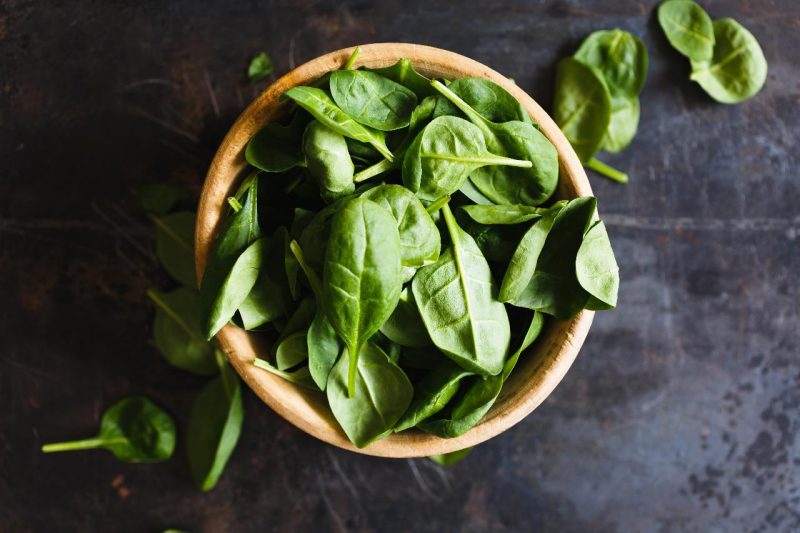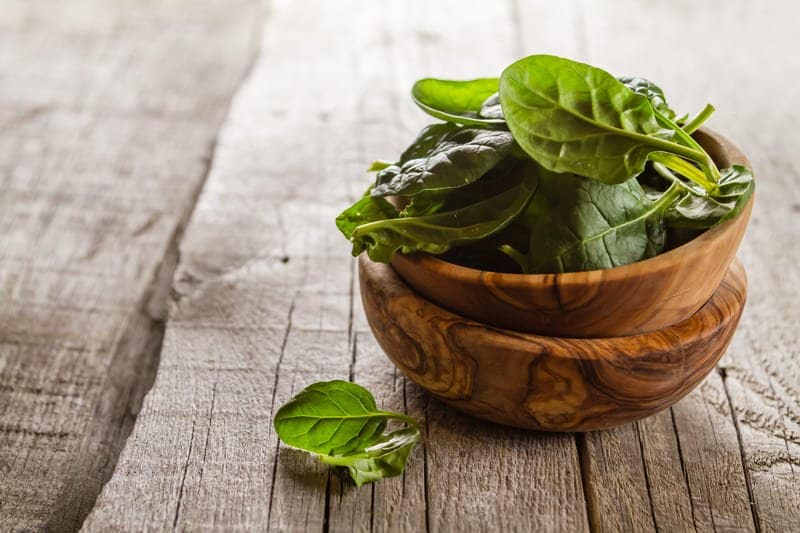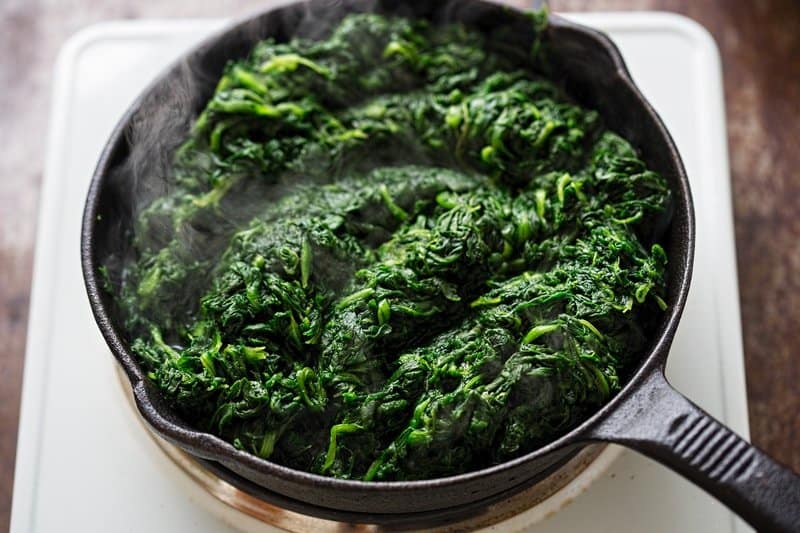Everyone has bought a bag of spinach with big plans and aspirations to create an amazing dish. But, frequently, just days later, you find the spinach wilted and slimy, left to be discarded.
Spinach is a versatile and healthy green that can be eaten either raw or cooked. It is high in vitamins, such as Vitamin A, C and K, as well as minerals like iron.
It has great medical benefits and research has shown that it can help prevent diabetes and cancer as well as helping to lower blood sugar levels.
Although spinach is a tasty and healthy vegetable, it can be unsafe to consume and also unpleasant to eat.
However, it is very easy to tell whether spinach has gone bad. The leaves will be a dark green or almost brown colour and be covered in moisture or have a slimy feel. The spinach will smell very sour and pungent, which means it also won’t taste nice.
How to tell if spinach is bad?
Pre-packaged spinach always comes with an expiration date, so this is a good indicator of how long your spinach will last. However, there are other signs which can allow you to determine its freshness.
There are multiple ways to tell if your spinach has gone bad:
- Slime: A layer of slime will be on the spinach and the greens will be wilted.
- Colour: The leaves have turned a yellow to dark green or almost brown colour, with bruising around it. If the leaves are spotty, this is a sign of disease, mould or rot so discard of the spinach immediately.
- Smell: There is a funny smell when you open the bag or container.
- Texture: If your leaves are sticky, shrivelled or have holes in, it means your vegetable is about to expire. It is best to discard the spinach as it will not be safe or nice to consume.
Good spinach on the other hand should be a bright green colour, with a fresh smell. A good test to determine the quality of your spinach is feeling it; the leaves should be dry, firm and crisp.
Also Check: 8 Best Spinach Substitutes
What does bad spinach smell like?
The smell of bad spinach can vary depending on the person, although the pungent smell is quite easy to detect.
It is best described as a ‘funny’ smell. Some may describe it as musty, sour or almost mouldy. But it is very easy to detect if spinach has gone bad – just see if you wrinkle your nose in disgust.
If the spinach does not smell right to you, discard it.
Also Check: Does Bacon Grease Go Bad?
What makes spinach go bad?
The vegetable’s composition is more than 90 percent water, which is why spinach turns slimy and wilts so easily.
Moisture and wetness cause the spinach to break down quickly and rot. Moisture mainly comes from condensation. The likelihood of condensation increases when spinach is left out of the fridge and sits at room temperature.
However, moisture can also come from the spinach leaves themselves. If your spinach is thrown carelessly at the bottom of the fridge, it can be squished by other products. When the leaves are crushed, they release liquid. This will only add to the moisture.
Is soggy spinach bad?
Soggy or wilted spinach is not safe for consumption because it means the spinach has started to decompose.
Over time, spinach can also become contaminated with bacteria, which is the main factor behind soggy or slimy spinach.
This is because bacteria thrive on wet surfaces, which means your soggy spinach could be covered in harmful microbes.
Do not rinse soggy spinach in an attempt to salvage it, it should just be disposed of.
Also check: How To Thaw Frozen Spinach: 5 Easy Ways
How long does spinach last in the fridge?
Fresh spinach can last between five to ten days in the fridge, although spinach is best consumed within a week.
If your spinach is intact and still in its packaging as well as being stored in a vegetable or crisper drawer in the fridge, it will most likely last for a week.
If your spinach has been opened and left unsealed in the fridge, it is more likely to last for around three to five days.
It is best to store your spinach in the fridge as it increases its shelf date. But, make sure that your spinach is not crushed.
How to tell if cooked spinach has gone bad?
Fresh spinach is not the only thing that can deteriorate, as cooked spinach can also lose its quality and safeness to eat pretty quickly.
Unlike the week-long shelf life of fresh spinach, cooked spinach should only be kept for around three to five days as long as it is refrigerated.
You must let the spinach cool before packaging it for the fridge. But only keep the cooked cooling spinach out of the fridge for a maximum of two hours. Any longer can increase the risk of contamination.
Do not consume cooked spinach after five days of its fridge life. Even if it looks ok, the spinach will no longer be safe to eat.
Should I wash my spinach?
Always wash spinach before eating it or cooking with it, as you should with all fresh produce. Spinach is susceptible to E-coli and salmonella, so it is essential to eat it clean.
Always wash your spinach before eating it or cooking with it – this is a rule of thumb for all fresh produce. Spinach is very susceptible to bacteria due to its water-based composition.
It is essential to wash all spinach before eating as the vegetable has been recalled for E-Coli and salmonella contamination multiple times in the past.
However, do not wash your spinach until you are about to cook with it or eat it. Exposing your spinach to any unnecessary moisture is a bad idea and can spoil it quickly.
Washing spinach before putting it back in the refrigerator is not a good idea because it is very difficult to dry the spinach. Water droplets can stay on it and spoil it.
Buying pre-washed spinach is fine as it will have been thoroughly dried before bagging.
Can I revive my spinach if it starts to go off?
As long as your spinach is not slimy or soggy, but just a little bit wilted, it can easily be revived. Rinse your spinach in ice water and then pat it dry before consuming or returning to the fridge for another couple of days.
This saves the spinach from dehydration and replenishes them; it gives the leaves a crisper feel and saves the spinach for another few days for consumption.
However, it is not recommended to eat wilted spinach raw, even after the ice water method. It can still be cooked with, but the lack of moisture in the leaves will make it taste a little off.
Slightly discoloured spinach can also be revived. If you notice a few of your leaves are starting to discolour, but a majority of the spinach still looks healthy, remove the discoloured leaves. This will stop them from discolouring and spoiling the rest of your spinach.
Can I increase the shelf life of spinach?
There are multiple ways to increase the shelf life of spinach, keeping your greens crisp and safer for consumption for longer.
1. Location:
- Storing spinach in the fridge will keep the leaves crisper and healthier for longer. Keeping spinach at room temperature will make the greens quickly deteriorate because of the amount of moisture in the air.
- Do not keep your spinach in the same place as other foods which may damage it. Foods that produce ethylene, like apples and bananas, should be kept far away from other fresh produce as it causes things to ripen quickly. This will only spoil your spinach faster.
2. Packaging:
- Make sure your spinach is always wrapped up, sealed, or stored in a container. This prevents any oxygen and moisture from coming in contact with the spinach. Both oxygen and moisture can cause the quality of the spinach to deteriorate quickly.
- Hard-shell packaging, like glass or plastic containers, are best to store spinach in. This is because the hard surface will prevent the spinach from getting crushed in the fridge. Squashed spinach spoils very quickly because of the moisture that leaks from the leaves.
- Store your spinach with a clean paper towel to prevent any moisture from building. The paper towel will absorb any moisture which may form in the container. Make sure that you change the paper towel every couple of days to ensure that the spinach is not sitting on a wet surface.
- If you know you will not be eating the spinach within the next few days, you can even separate the layers of spinach with clean paper towels to extend its shelf life even further.
- If spinach is not the only vegetable you find that spoils quickly, perhaps invest in a produce container. These types of containers are designed to keep moisture away from the produce, helping increase their shelf-life.
3. Type:
- The type of spinach also plays a big factor in its shelf life as different types can last longer.
- Mature spinach will have a longer shelf life than baby spinach because the leaves are much harder and crisper. This means mature spinach leaves are less likely to get damaged and therefore decay. Baby spinach leaves are a lot softer and more fragile, so they will spoil more quickly.
Can I freeze spinach?
If you think your spinach is going off soon and you won’t have time to consume it, freeze it! This is a great way to make your spinach last longer.
Firstly, blanch your spinach in boiling water for just under 30 seconds before putting the greens in ice water.
Allow the spinach to cool for two minutes, before squeezing out any excess water. Sieves are a great way to get extra water out of spinach. Pat your spinach until it is close to dry, then place the spinach in a freezer bag.
Your frozen spinach will keep its quality for just under a year.
Conclusion:
It is very simple to determine whether your spinach has gone bad. The colour of the leaves, changing from a bright green to a dark almost brown colour, is a very good giveaway.
The texture of the leaves is also a great indicator; any sliminess or sogginess are an obvious sign of bad spinach.
The clearest sign of bad spinach is the smell – a musty almost sour smell spells trouble, so discard your spinach.
Spinach may not always be dangerous to eat, but there is a high chance of bacteria and contaminants on spoiled leaves. This can leave you ill or give you food poisoning, so it is always safe to discard bad spinach.




